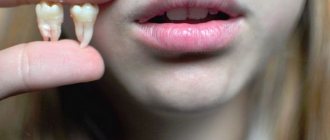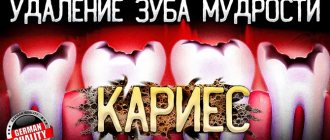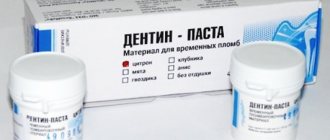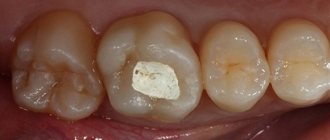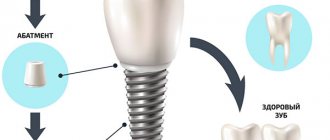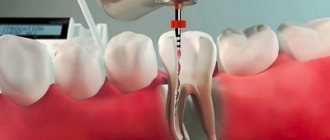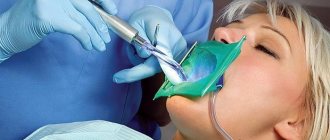Is it possible to put arsenic in a tooth?
Arsenic is a chemical element that belongs to immunotoxic substances, that is, poisons.
It disrupts the exchange of selenium, sulfur and phosphorus in tissues, which leads to a lack of oxygen, hypoxia and, as a result, cell death. In dentistry, it is not pure arsenic that is used, but a paste with arsenous acid anhydride in combination with various anesthetic and antiseptic components. Below, by arsenic we will mean a paste, and not a pure chemical element.
The toxin was first used for dental treatment in 1836. Nowadays, treatment methods have changed significantly, but in some cases dentists still use acid.
In the article Stom-Firms.ru we will tell you why arsenic is placed in the tooth during treatment. We will describe how and for how long it is placed, and also list the complications that may arise.
How harmful is it?
Arsenic is a poison, but in dentistry it is used in very small doses and is not dangerous when used correctly. The instructions for use state that the maximum dose should not exceed 0.0008 g.
The main tasks are to take precautions, inject the drug into the tooth pulp without introducing dirt, and monitor the health and the body’s reaction to the substance.
If arsenic begins to kill healthy tissue, then even after its removal some of the paste will remain, later leading to inflammation.
Why does pain occur?
Immediately after applying the substance, the tooth may hurt for several hours in a row.
Immediately after applying the substance, the tooth may hurt for several hours in a row. This is a normal situation in which there is no need to panic. After time, the pain will subside.
In the first days after the substance is installed, there is a possibility of pain. This is a consequence of the effect of arsenic on the tooth root.
The paste usually contains anesthetic substances - lidocaine, novocaine or dicaine. They guarantee pain reduction, making the process of nerve death painless.
But in special cases, unpleasant sensations may persist (due to increased sensitivity of the body or incorrect installation). If the pain persists, then perhaps the doctor prescribed an insufficient dose of anesthetic.
As soon as the nerve is killed, the pain will disappear. After this period, you can go to the doctor and carry out further treatment.
However, if pain persists after this, this indicates that the necrosis process has affected the jaw bones. Consult your doctor - the drug may need to be removed immediately.
Why did the temperature rise?
The doctor, having established arsenic, in addition to pain relief, advises the patient to purchase antipyretic drugs in case the body temperature rises during the period of root necrosis.
If the doctor made a mistake during installation and installed the filling too tightly, then drug-induced inflammation may occur, accompanied by:
- The appearance of edema.
- Temperature increase.
- Increasing pain.
This leads to the formation of an abscess on the gums. The affected area should be immediately shown to a specialist.
Why does a temporary filling fall out?
While the temporary filling is in place, change your diet and eat exclusively soft foods that will not lead to cracks or breaks.
The temporary filling must be intact during the period of nerve killing.
It ensures the tightness of the internal cavity of the tooth, preventing the drug from entering the oral cavity.
Otherwise, there is a risk of the aggressive substance coming into contact with healthy tissues, or food getting into the affected area.
To do this, the doctor advises, while the temporary filling is in place, to change your diet and eat exclusively soft foods that will not lead to the appearance of cracks or breaks.
But the hardness of the filling also depends on the materials used - if high-quality materials are used, the patient is allowed to eat on both sides, practically without limiting himself in food.
However, the temporary filling should not be too dense either - otherwise it will put strong pressure on the tooth pulp.
This, by the way, is another factor in the appearance of pain. In this case, if there is pain, the patient will not be able to remove it on his own and will have to go to the dentist.
Indications and contraindications for the use of arsenic
Arsenic acid is used for devitalization, that is, killing the dental pulp in order to then partially or completely remove it. Before the development of anesthesia, this was the only way in which it was possible to remove a tooth relatively painlessly, cure pulpitis and some other dental diseases.
Now the pulp is removed under local anesthesia and using drugs without arsenic. But there are indications according to which he is still placed. These include:
- Acute diffuse or chronic fibrous pulpitis;
- Chronic hypertrophic pulpitis in teeth with impassable and curved canals;
- Allergy to local anesthetics;
- Severe general condition, for example, after a heart attack or stroke;
- Inability to open the mouth wide due to contraction of the lower jaw.
Dentists emphasize that arsenic is not an alternative to pulp removal with anesthesia. The toxin is used as a last resort when the patient has indications for it.
Arsenic should not be placed in the dental cavity if:
- Allergies to paste components;
- Pregnancy and lactation;
- Increased eye pressure;
- Diseases of the urinary system;
- Unformed roots.
In pediatric dentistry, arsenic should not be administered to children under 1.5 years of age. But today, paste with arsenic acid is practically not used to treat pulpitis in a child. Pulp devitalization is carried out with other drugs.
Removal of tooth nerve with arsenic
Removing pulp using arsenic is considered an outdated treatment method, which is almost never used today. The procedure was quite simple: the tooth was prepared using a drill, then the root canals were expanded, medicine was applied to remove the nerve in the tooth, after which a temporary filling was installed for 2 - 3 days. The negative side of such treatment is that arsenic is a strong poison that has a detrimental effect on both the tooth and the tissues surrounding it. With the advent of new safe techniques, the need for arsenic has disappeared.
How to put arsenic in a tooth
Depending on the age of the patient, the condition of the pulp and the size of the tooth, the doctor determines how much paste is needed. Typically, its amount varies from 0.0002 to 0.0004 mg.
Let us describe the stages of the procedure:
- The dentist uses an excavator to remove food debris, damaged tissue and thinned dentin from the carious cavity;
- A ball-shaped paste is placed on the pulp horn and covered with a bandage;
- Hermetically seals the cavity with a temporary filling.
Sometimes doctors put the paste on the unopened pulp. Then, after the procedure, the tooth may be very painful, especially when pressed, because swelling occurs and pressure in the tissues increases.
Usually, adults put arsenic in single-rooted teeth for 24 hours, in multi-rooted teeth for 2 days, but this period can increase to 6 days depending on the manufacturer and brand of the drug. Then the patient comes back for an appointment, and his pulpitis is treated in the traditional way: the temporary filling is removed, the cavity is prepared, the pulp is removed or amputated, the canals are processed and sealed.
How is arsenic used?
To kill a tooth, you will need to visit the dentist twice:
- The first time is to install the substance.
- The second is for removing it.
Installation
The procedure for your first visit is as follows:
- The doctor refers the patient to X-ray diagnostics of the diseased tooth. Having received the photo, he, focusing on it, will open the carious cavity. Then the inside of the tooth is cleaned of dead tissue.
- Then arsenic is placed on the site. A small cotton ball soaked in an anesthetic can be placed on top of it, which should relieve discomfort.
- The inside of the tooth is then sealed with a temporary filling to prevent dirt from getting in. The patient is released for 1.5-2 days. The doctor will tell you the exact number of days when scheduling the next visit.
Usually, the patient is advised to call if particularly severe pain occurs. If medications do not help and the condition worsens sharply, the doctor may advise you to go to the nearest dental department and remove the temporary filling, or do it yourself.
Arsenic installation process
Extraction
At the second appointment, the dentist removes the temporary filling. The cavity inside the tooth is carefully processed and then cleaned of arsenic residues. Then the doctor, having checked the sensitivity of the nerve, proceeds to remove it.
To make sure that the arsenic has been completely removed, a dye is added to the preparation before installing it, making the substance easy to see on the walls of the tooth.
Self extraction
If for any reason after applying the drug, prolonged pain appears, this means that the negative effect of arsenic has spread further to healthy tissues. In order not to delay removing the filling and paste, the patient can do it himself.
First, remove the filling itself: they are made of soft materials and are easily pryed off with a needle. The paste itself is also cleaned with a sharp, thin object (tweezers).
The main task is not to ingest arsenic during cleaning. Any instrument must first be disinfected, and then cover the open area with a cotton ball or swab.
Then the oral cavity should be rinsed with a solution of soda, iodine or hydrogen peroxide. Plus, you can rinse your mouth with milk - it also helps to neutralize any remaining substances. Afterwards, you should visit your doctor as soon as possible to avoid complications.
What to do if complications arise when using arsenic
If the doctor correctly selected the dosage and hermetically installed the temporary filling, and the patient came for a follow-up appointment on time, there will be no complications after using the paste. They occur if the therapist used too much of the substance, did not install the filling tightly and it fell out, or when the patient missed the deadline for taking it and walks with arsenic longer than expected.
The most common complications include:
- Burn of the mucous membrane, for example, gums;
- Necrosis of surrounding tissues and pulp of adjacent teeth;
- Arsenic periodontitis and periodontitis;
- Osteonecrosis is the destruction of jaw bone cells.
If arsenic falls out, the patient has a headache, feels sick and vomits, contact the clinic immediately. When the poison enters the body, the doctor administers an antidote. In case of damage to the mucous membrane, treat the affected area with antiseptics and drugs that block the spread of the toxin and accelerate tissue epithelization.
In modern dentistry, to avoid overdose, the paste is produced in special granules. The main thing that doctors urge is not to overexpose arsenic: keep it for as long as you are prescribed to walk with it. Then the risk of complications becomes minimal.
How to clean
This manipulation should be approached with all responsibility. All rules must be followed so as not to cause harm. It is very important to pay attention to disinfection. The workplace should be well lit. If there are someone close to you, then it is better to enlist their help. If there is no one, then you can simply arm yourself with a mirror.
Procedure algorithm:
- Brush your teeth, remove plaque.
- Wash your hands using an antibacterial product.
- Select the tool that you plan to use to extract arsenic. It could be a syringe, a sewing needle or any other. Wipe it with a solution of potassium permanganate or alcohol.
- Using smooth and careful movements, remove the upper part of the soft filling material. We must try to act in such a way as not to violate the integrity of the substance. Don't go too deep to avoid damaging your gums. The extracted gray pulp is immediately pulled out of the mouth. If you accidentally swallow it, it can cause serious consequences.
After the manipulation is completed, it is recommended to rinse your mouth with a soda solution or chamomile decoction. Apply sterile gauze to the tooth, which will act as a barrier between the dead nerve and the food. It is advisable to visit a doctor on the same day so that he can install a filling.
More information on the topic
When they use arsenic and why, you will learn even more in the articles:
- Deep caries
- Treatment of periodontitis
- Dental prosthetics
References for the article:
- Kostina I.N., Nikolaeva A.A. “Arsenic necrosis of the jaw - complications in the treatment of dental pulpitis” // “Problems of Dentistry” No. 3, 2010.
- "Endodontics. Pulp diseases" // Textbook / A.S. Opravin et al. – Arkhangelsk: Publishing House of the Northern State Medical University, 2016.
